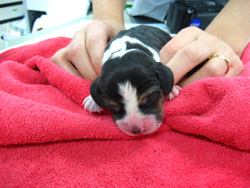Ruppy: Teaching old dogs new tricks
By focusing on teamwork, communication, and strong relationships, successful collaboration between clinicians and other providers can be achieved.
Getting disparate groups to work together can be a daunting challenge. Anyone who has been through a practice merger can attest to this. But next time you are sitting in a meeting and you hear someone say, “Our cultures are too different” or “This is impossible; they have a different view of the universe,” think about Ruppy.
The world's first transgenic dog, Ruppy (for “Ruby Puppy”) made his debut alongside four of his fellow transgenic brothers and sisters in April 2009. A team of scientists led by Byeong-Chun Lee of Seoul National University in South Korea created the transgenic dogs through the use of retroviral integration to transfer a fluorescent gene—normally expressed by sea anemones—into dog fibroblast cell nuclei. The fibroblast cells' nuclei were then introduced into separate dog egg cells, which had had their original nuclei removed. After the egg cells had divided, the cloned embryo was implanted into a surrogate mother. The transferred gene codes for a fluorescent protein that glows red under ultraviolet light when it is expressed.

Scientists are interested in using the transgenic dogs as models to study human disease and cancer pathogenesis. Transgenesis is a notoriously laborious and expensive method of studying gene expression. The scientists began with 344 embryos, which they implanted into 20 dogs; this resulted in only seven pregnancies. One of the fetuses died in utero, while an 11-week-old puppy died due to complications from pneumonia. Five of the puppies survived in utero and are alive and healthy, and will soon begin to give birth to the next generation of fluorescent puppies.
Aside from the low efficiency of cloning (just 1.7% of the embryos came to term), another common problem is controlling where the cloned gene inserts into the nuclear DNA. The team of scientists responsible for the creation of the transgenic puppies used a retrovirus to insert the gene into the canine nuclear DNA, but they were unable to control where the virus inserted into the gene. Presumably, this would prevent researchers from using the transgenic dog as a model to study the role of gene deletion in cancer pathogenesis or using the dog model to study mutant forms of a gene. These knockout procedures, also known as gene targeting, are commonly performed in mice and rats.
Despite the limitations, the production of a transgenic dog model is considered to be an important accomplishment in showing that cloning and transgenesis can be applied to a wide range of mammals. Through the combination of a special fluorescent gene and a puppy, we now have a model (albeit an imperfect one) to study cancer and other pathological processes.
If two such different organisms can be combined to produce a working model for studying disease mechanisms, why should effective interdisciplinary collaboration between nursing staff and physicians be so difficult to achieve?
Research suggests that health care can be improved and patient harm reduced when health professionals successfully collaborate across professional boundaries. A recent study in the Journal of Interprofessional Care (Reeves et al., 2009) included more than 155 hours of observation and 47 interviews from a variety of health professionals. The investigators found that interprofessional interactions were “terse” and consisted of “unilateral comments from physicians to other health professionals.”
In contrast, interactions between other health professionals were “richer and lengthier” and comprised negotiations. The benefits of interdisciplinary collaboration include improved job satisfaction for clinicians and higher quality of care for patients.
As with transgenesis, the process of achieving interprofessional collaboration is not likely to be without complications. But by focusing our efforts on teamwork, communication, and strong relationships, successful collaboration between clinicians and other providers can be achieved. After all, if a chimera of a cnidarian and a canine can make a glow-in-the-dark doggie, anything's possible.


